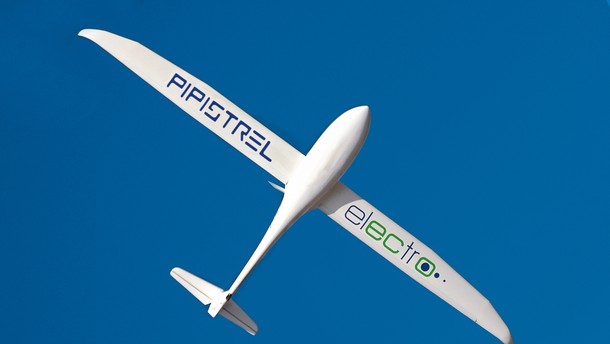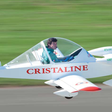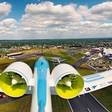

You say it's blue? Well, we would bet that the sky above the Slovenian town of Ajdovščina was green. At least the people who work at Pipistrel see it that way. And they strive to turn the sky green all around the world. How else to explain their pioneering production of electric aircraft, which represents alternative power in aviation?
WATTsUP, Taurus Electro, and the hybrid and electric Panthera are models that show the direction of Pipistrel. The folks who work at this trendsetter in green aviation still remember the late 1970s and early 1980s, when a sudden love for aviation led Ivo Boscarol, a printer at the time, to manufacture a powered hang glider. "They're bats," exclaimed the local observers on the ground who first saw his gliders soar high above them, and so the founder came up with the name of his company. Pipistrellus is Latin for "bat."

The company, which has 100 employees, celebrated its 25th anniversary last year. After about a decade of manufacturing powered hang gliders, they added ultralight aircraft to their line-up, and it didn't take long for Pipistrel to become a name renowned among producers of this niche product. Aircrafts Sinus was followed by the enhanced Virus, while Taurus, with its auxiliary engine for autonomous takeoff, offered a new experience in gliding. Then the Taurus Electro became the first completely electric two-seater aircraft in serial production.
The designers at Pipistrel are firm believers in the superior power of electricity over regular gas-powered internal combustion engines. Compared to the traditional Taurus, the electric Taurus has a shorter takeoff distance, climbs faster and responds better to high altitude maneuvers. Climbing is facilitated by a 40kW electric motor, specially-developed at Pipistrel, while custom-made lithium ion batteries, in two configurations, lift the glider up to 4000 feet (approx. 1200 meters) or even as high as 6500 feet (approx. 2000 meters).

Compared to its predecessor, the electric motor of the second generation of the Taurus Electro (referred to as G2) is five kilograms lighter, weighing in at only 11 kilos, and is 10kW more powerful, with the superior package topped off by a more efficient propeller. Pipistrel is so committed to increased efficiency and harnessing every atom of energy, especially if it is acquired in an environmentally friendly way, that Boscarol, in true Steve Jobs' style, has come up with another concept – Flying For Free. On the cover of the Solar Trailer, used to transport the electric Taurus, you'll find solar cells which completely restore the Taurus' energy supply in five hours, with zero emissions. From the sun on the ground, straight up into the sky. 12V and a 110/220V electricity supplies are available, and a bypass enables the Taurus Electric to be charged via an external connection, when it is stored in the trailer.
With solutions like this, the prizes and awards have flowed in. The company's trophy cases contain an award for the most innovative company in the EU, awards for three consecutive victories in NASA competitions, and the Gold Order of Merit from the President of Slovenia. But not even the latter can help with the strict bureaucratic procedures which prevent the sale of aircraft in the USA, if they are manufactured in Slovenia. Since the countries have not signed an agreement, aircraft from Ajdovščina cannot be sold across the pond. For this reason, a new production facility is being built quickly, just across the Italian border.
In 2007, Pipistrel expanded east. Literally. An eastern wing was tacked on to their headquarters. However, the company scans all directions of the sky, far and wide, and around the world. They like to say that their building is still among the greenest in Slovenia. It is completely self-sufficient, in terms of energy, as it has no fewer than 11 systems for rational energy use, and its north–south axis maximizes the efficacy of the solar panels that line the roof. The projecting roof ensures that all windows are shaded during the summer, while the solar elevation angle in the winter is aimed at the floor of the premises, thus contributing to heating. The building also has underfloor heating, underfloor cooling, geothermal wells, a geothermal storage reservoir, a heat pump and cogeneration plant, among other eco-features. And, of course, it was designed in harmony with the ideas of the innovator, Ivo Boscarol.

The numbers speak proudly of savings – all these systems save 95,000kWh annually, which is the equivalent of 180 tons of carbon dioxide emissions. The complete energy self-sufficiency of the building means that it has electricity to run, even when the famously-harsh Bora winds flatten trees in the Vipava Valley. The one downside to this is that employees never get a day off due to extreme weather!
In this spirit, and with the intention of learning to fly in an environmentally-friendly way, Pipistrel launched their latest concept, WATTsUP: the first entirely electric two-seater ultralight trainer aircraft. What a design. The short takeoff distance, powerful 1000+ fpm climb, and a power duration of one hour, plus a 30 minute reserve, are practically ideal performances for a flight school aircraft—just what the modern generation of pilots needs. Since training most often consists of flying patterns above an airfield, the WATTsUP can recoup 13% of energy on every approach, and facilitate shortfield landings.
"With the ever-growing cost of fuel, it is time to rethink pilot training," says Ivo Boscarol, adding that, with his new aircraft, the cost of ab initio pilot training could be reduced by as much as 70%. The first response of the market has been exceptional, and serial production is about to be launched. Being able to conduct training on smaller airfields with short runways, with zero emissions and noise, is absolutely a game changer.
Dr. Frank Anton, head of the electric aircraft team at Siemens, is also convinced that the ever-growing cost of flying can only be reduced by innovation. Pipistrel collaborated with the German company, Siemens, in developing WATTsUP, their fifth electric project and the second commercial venture, with Siemens providing key components of the electric drive. With a vision to make each component of the aircraft as light as possible, the scales tip at 14 kilograms for the 85KW motor. Such a machine is even more powerful than the popular Rotax 912. The 17 kWh batteries are quickly charged in under an hour, and the system of replaceable batteries facilitates the charging of one pack while the aircraft is airborne, followed by a simple replacement of the empty batteries with full ones, for example, during the changeover of student pilots on the ground.
The electrification of flying is still somewhat limited by the weight of the batteries, since every gram counts when you're airborne, as well as by the length of time they can run without being recharged. Nevertheless, progress in the development of electric aircraft is extraordinary. Pipistrel prides itself that it took them five years, starting in the early 1990s, to create the Sinus, from concept to manufacture, while it only took them only five months to design an aircraft for the NASA Challenge in 2011. Layers of composite materials, glass and carbon fiber, including Kevlar, are today the basis of modern aircraft, but only the first five prototypes of each aircraft are completely made in Ajdovščina. The molds are made there, and then plans are submitted to external suppliers, which manufacture the components. Around 90-95% of all the components for serial production are made outside Pipistrel, as the small series—the manufacture of about 10 aircraft per month – would mean a substantial investment for modest production, whereas the suppliers can do it better, faster and cheaper.

The components come from all over the world. They therefore undergo strict quality control, to ensure they meet Pipistrel's exacting standards. Pipistrel, which licensed and took over Toyota's patented Kanban system (scheduling system for lean and just-in-time production), is among the most meticulous aircraft manufacturers, and can be compared favorably with the best in the market (Airbus, Boeing). Pipistrel's aircraft fly in 85 countries, and the company invests all its spare money directly into development, with nothing going to marketing and advertising. It has already been confirmed that the latter is not necessary. Their reputation as a great innovator has spread far and wide, and their transition from the ultralight category to general aviation, beginning with the brand new Panthera, has already attracted the attention of the aeronautical world.
The classic Panthera, with its Lycoming petrol engine, has already clocked up countless hours of flying, but the modern design of the fourseater is especially exciting, particularly with the hybrid and completely electric drives, which will be available in the near future, shortly to be mass-produced. While the hybrid electrically-powered Panthera will facilitate inaudible takeoffs and landings, the objective is for the completely electric Panthera to facilitate flying up to 400 kilometers (215 nautical miles) at a go. But we will have to wait some time for its first flights. A lot longer than for flights with the Taurus Elctro G2 and the WATTsUP, both of which would have been ready for Plugin's visit, if they were not being prepared for the AERO show in Friedrichshafn, the most important aviation event in Europe. Meanwhile, in Ajdovščina, much like in the car industry, they are already thinking about hydrogen fuel cells, natural gas and other potential alternative fuels. The sky's the limit.


